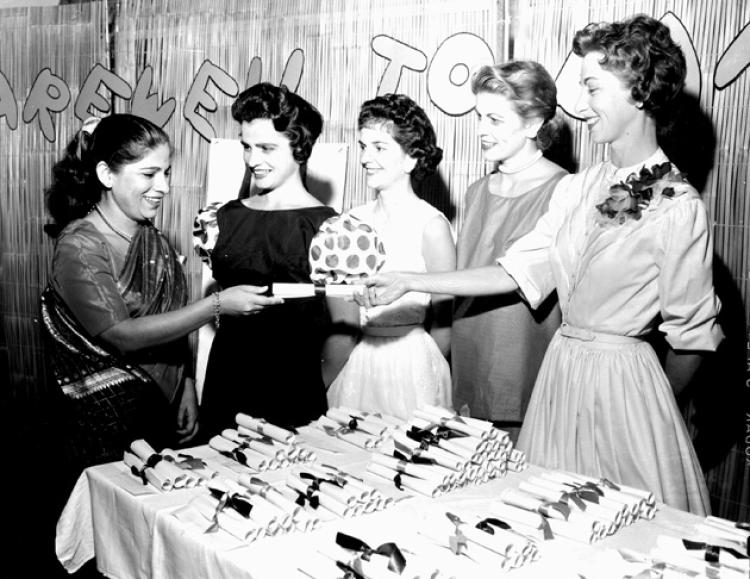A study co-authored by a CU Boulder economist reveals how young wives played a significant role in financially kick-starting their families during the economic prosperity of the 1950s, also opening the door to greater equality for women later in the century
The 1950s were marked by rising prosperity, as the U.S. economy grew rapidly and unemployment remained low. They are also remembered for strict gender roles: men as breadwinners and women as family caretakers.
But a study published recently in Journal of Labor Economics suggests that many wives provided for their husbands through college, freeing their families from the credit constraints of higher education.
Murat Iyigun, a professor of economics at the University of Colorado Boulder who co-authored the paper with Jeanne Lafortune of the Pontifical Catholic University of Chile, is interested in a phenomenon of the 1950s that has puzzled sociologists and economists: Why were couples marrying younger while men became more educated than women?

At the top of the page: While the University of Florida honored its male graduates, the University Dames recognized supportive wives with “Putting Husband Through” degrees in ceremonies like this one in 1960. Awarded for their “loyal support and unfailing patience,” these women often worked and raised families while their husbands attended class. The Dames, sponsored by the University Women’s Club, organized in 1948 and helped women learn skills needed for their husbands’ future professions through monthly talks on everything from meat purchasing to home decor. The Dames later disbanded, but the Women’s Club (faculty wives and female faculty members) continues today. (From UF Today, Winter 2009) Above: Professor Murat Iyigun’s current interests of study are economics of the family, economic development and growth, political economy and cliometrics.
According to Iyigun, “the 1950s was an anomaly. The 1880s looks in some sense like now, because people used to get married later and the education levels between husband and wife were more comparable.”
Unlike other cultures, married couples in the United States are expected to move out of their parents’ homes and into their own, which can be expensive. In the poorer economy of the early 20th century, both spouses had similar but lower levels of education and often chose to put off their marriages until later in life.
“But the ’50s is the American heyday. It’s the golden era of the post-Second World War and there’s a huge American middle class. Housing became very cheap, which explains early marriages because younger people could afford it. And suddenly, the education premium for men rose,” Iyigun says.
On the flipside, financial returns for women receiving college degrees remained lower than for men.
“Besides other factors, discrimination kept the returns to schooling for women lower than those of men in the 1950s, ’60s and even the early ’70s,” Iyigun says.
However, later in the 1980s, “college and higher degrees started to pay off more for women.” With more women obtaining degrees alongside men by the late 20th century, marriages at later ages increased.
Sociologists and economists have offered different theories about how marriage timing and the educational gap between genders made the 1950s stand out. To solve this mystery, Iyigun created an analytical model that accounted for the changes in the start-up cost of marriage and tuition throughout the 20th century, and whether this generates an interaction between when couples married and became educated.
Comparing the model’s predictions with historical data, it successfully mirrored the trend of early marriages and wide educational gaps between genders in the 1950s, and showed that the pattern of later marriages and comparable education levels between genders returned in the late 20th century.
“Using our model, with a drop in home prices and an increase in the education premium for men, we now have couples who can marry early, and if it made sense for the husband to get an education, the wives typically supported them; they’re joining the labor force starting in the ‘50s,” Iyigun says.
For Iyigun, his model supports the claim that the 1950s was an exceptional moment in the economic and domestic history of the United States.
“It was a cultural phenomenon that even institutions recognized. Schools were having a separate diploma ceremony for the wives of men who were getting a degree, and their degree was called the PhT (Putting the Husband Through). They were congratulating women for supporting their husbands getting an education.”
“Even modern obituaries cite the PhT; it was something women were proud of doing,” Iyigun says.
It was a cultural phenomenon that even institutions recognized. Schools were having a separate diploma ceremony for the wives of men who were getting a degree, and their degree was called the PhT (Putting the Husband Through). They were congratulating women for supporting their husbands getting an education.”
Although the PhT phenomenon was primarily an economic strategy to help husbands become educated sooner during marriage, Iyigun believes the fact that women were supporting their husbands through college laid the groundwork for the major cultural changes of the late 20th century.
Today, “the ’50s seems like a bygone era, but I think there’s a backdrop where the culture has shifted, and much of the family structure, men and women’s roles in the household, in the workplace and in society drastically changed in many ways for the better,” Iyigun says.
Iyigun, along with Lafortune and Paula Calvo of Arizona State University, are working on a paper investigating how divorce laws factored into the marriage age, education and economic trends of the 20th century.


